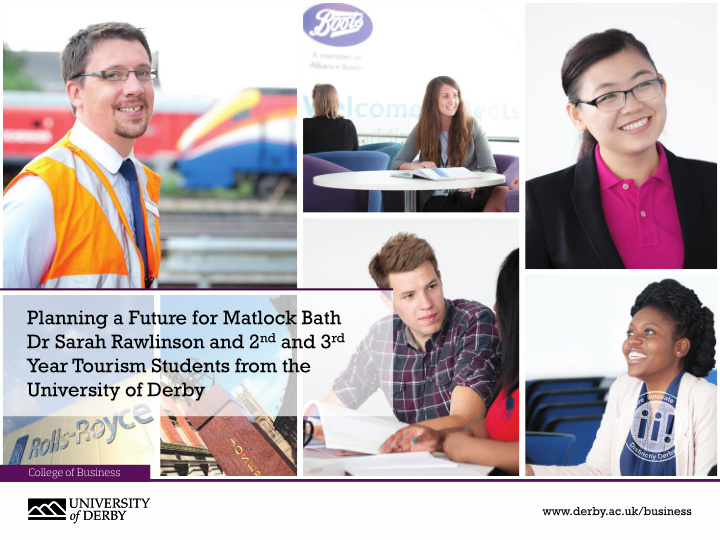



Planning a Future for Matlock Bath Dr Sarah Rawlinson and 2 nd and 3 rd Year Tourism Students from the University of Derby www.derby.ac.uk/business
Purpose of the project Aim Undertake a tourism destination audit and propose a destination management plan for the future of tourism in Matlock Bath. Objectives • Conduct a destination audit • Conduct stakeholder surveys • Provide a competitor analysis • Provide a live case study of the challenges and opportunities of repositioning a tourism destination for tourism students at the University of Derby www.derby.ac.uk/business
What will we do? Access the destination • Quantity – of what is offered • Quality of what is offered • Distinctiveness of the offer • Risk to change and threats Analyse external trends • General economic, social and environmental trends that may influence performance • Tourism market trends • Trends in technology Provide a competitor analysis • Aspirations to be a market leader • Strengths and weaknesses • What could be done differently • Future linkages and collaborations www.derby.ac.uk/business
Secondary - Desk Based Research Evaluate the tourism offer and audit products in Matlock Bath • Overall appeal and appearance of the landscape, built environment, heritage and culture, • Accessibility including transport links • Infrastructure including accommodation, attractions, events • Visitor services including marketing media, signposting, car parking, toilets and other services. Identify the importance of the visitor economy to Matlock Bath • Business stakeholders • Community stakeholders • Local authority • Cultural and heritage partners • Tourism performance and impacts www.derby.ac.uk/business
Primary Research - Business Survey Nature of the businesses • Size, employment, management, networking Level of performance • Opening times, seasonality, Markets served • Who are the customers, market trends, customer needs Barriers to successful performance • Investment intentions and issues, training and development needs, marketing, Destination management • current destination management issues, engagement and communication with the destination, key issues concerning the destination www.derby.ac.uk/business
Primary Research - Identifying local issues The local economic and political context for tourism development • Community awareness • Pressures on resources • Transport and other access issues New project developments • Perceived opportunities and threats Economic impacts • Economic linkages through the supply chain www.derby.ac.uk/business
Primary Research -Visitor Survey Visitor profiles • Where they come from, age profile, who they travel with, motivation to visit Visitor perceptions • What do visitors think of Matlock Bath and does it meet their expectations? Would they come again? Information on visit • Previous visits, awareness of the destination, purpose of visit, transport used, how long they stay, how much do they spend Activities • Places visited, use of services, activities undertaken www.derby.ac.uk/business
Outputs • A full analysis of the tourism offer and product in Matlock Bath • A visitor profile and motivations • Results of business survey • Results of conclusions from community stakeholders • Results of a competitor analysis • Full analysis of Matlock Bath’s market appeal www.derby.ac.uk/business
What next? Secure funding to implement the action plan Some organisations are more successful at securing grants due to their commitment, hard work and, above all, the reputation they have built for delivering results. This project will provide evidence to any future funding body the community of Matlock Bath - has a clear and specific vision of what it wishes to do, how it aims to achieve its goals, and the benefits/differences that will be derived from the project for its target group; - has a strong management committee that is dedicated and democratic; - has a good, clear and precise understanding of the project and its purpose. www.derby.ac.uk/business
Recommend
More recommend